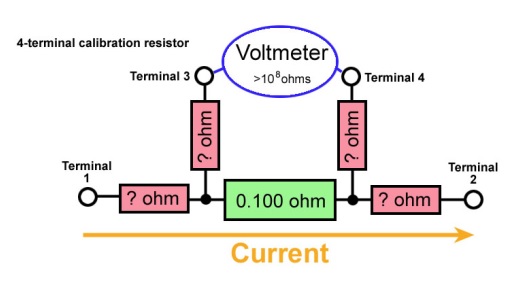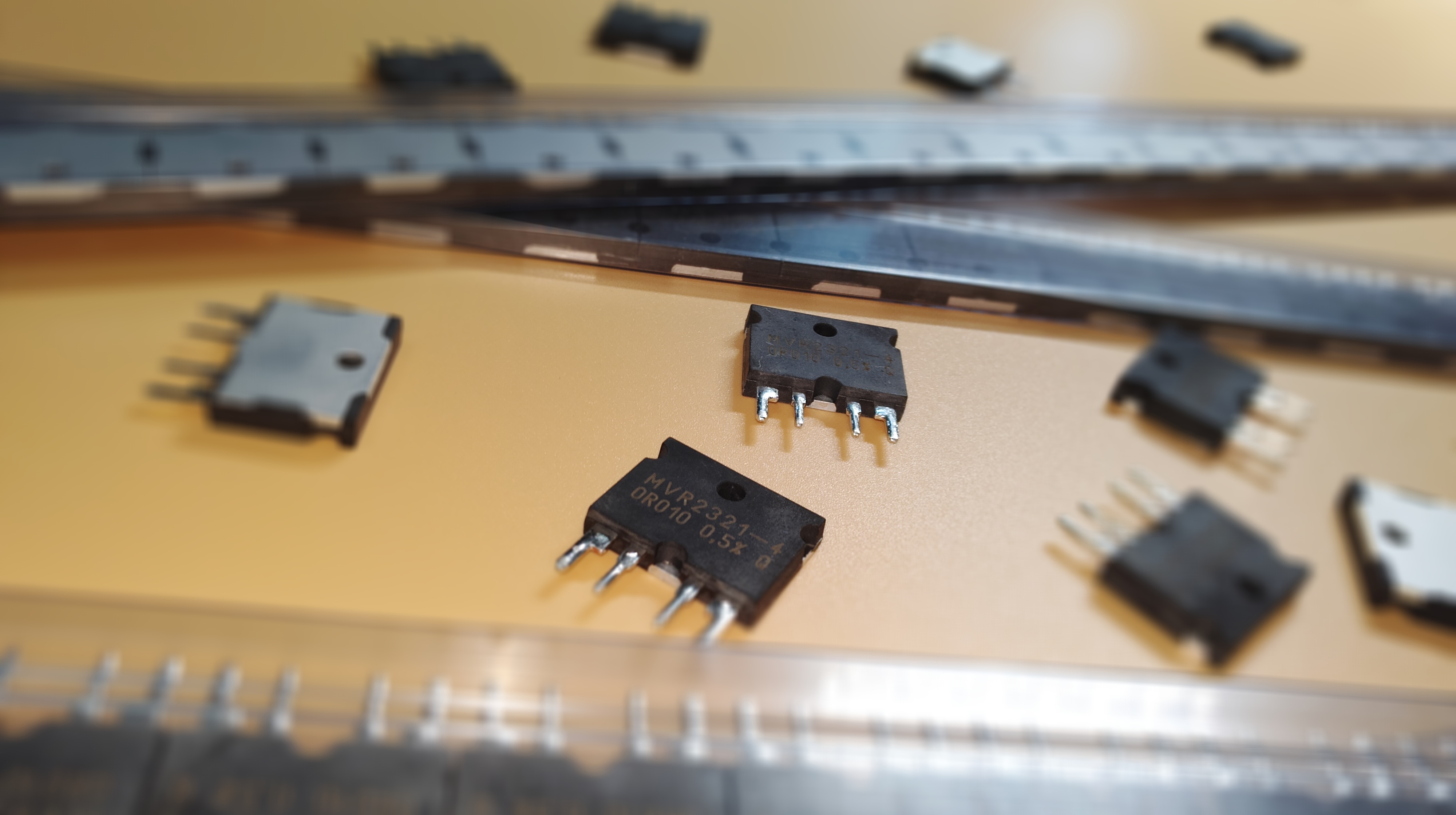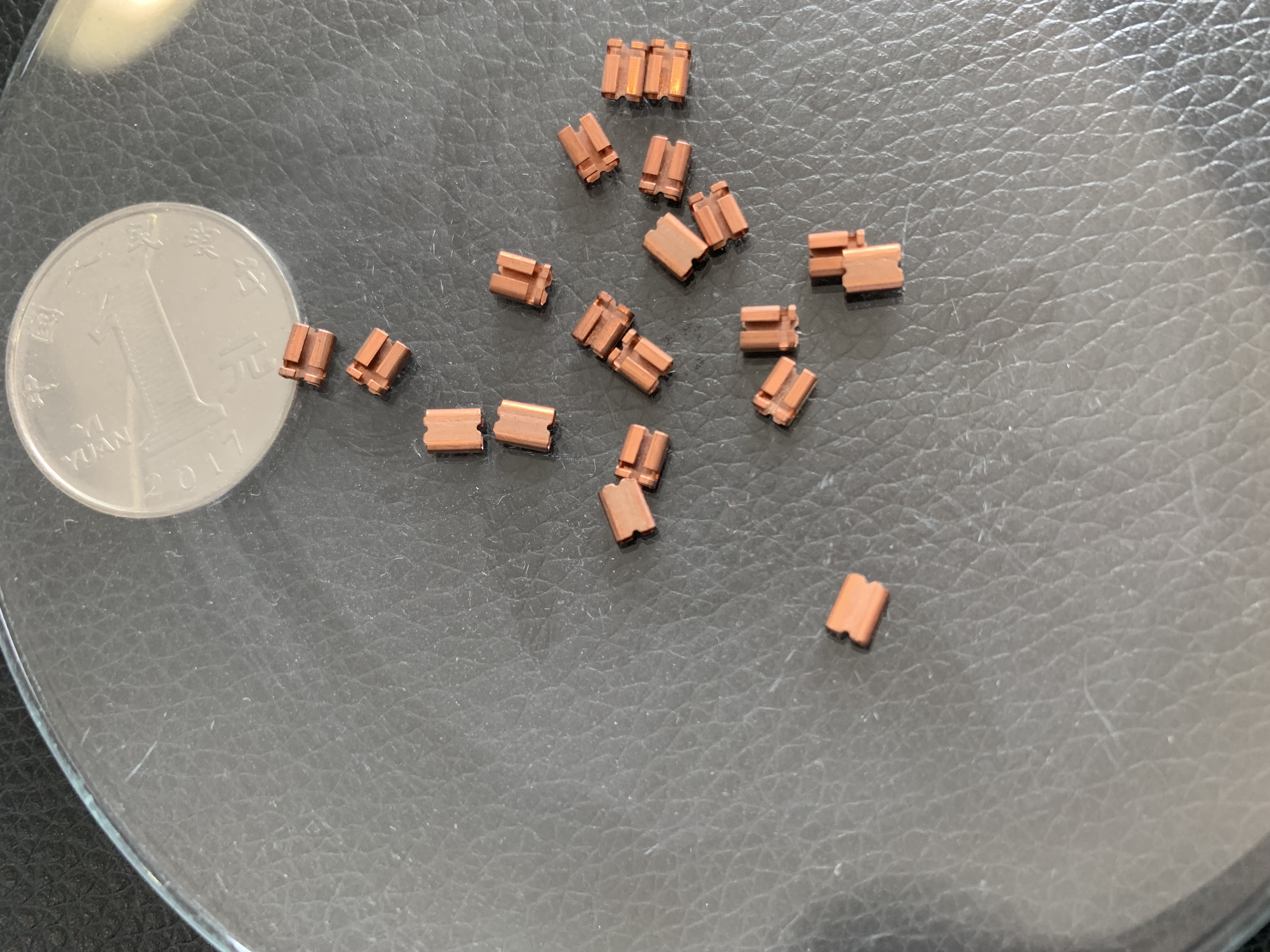Position:Home » Technical Articles
4-Terminal Resistors Work Principle
Writer:Microhm Page View:Date:2019-08-22
In a 4-terminal resistor, an ultra-precise resistor (green) is connected to 4 terminals through small, but unknown, resistors (red). These unknown resistors are the combination of lead resistance, screw terminal resistance, connection wire resistance, and other sources of errors.
 Typical values for these unknown resistors range from 0.01 ohms to 0.2 ohms, and the values are often unstable. The values can change when you loosen or tighten a screw, for example, or if you substitute a longer test lead.
Typical values for these unknown resistors range from 0.01 ohms to 0.2 ohms, and the values are often unstable. The values can change when you loosen or tighten a screw, for example, or if you substitute a longer test lead.
To use a 4-terminal resistor, we force a current from Terminal 1 to Terminal 2. It’s current, so the unknown resistances attached to Terminal 1 and Terminal 2 don’t affect the amount of the current. The same number of electrons per second flow through from T1 to T2, regardless of the resistance.

A voltmeter measures the resulting voltage drop across the ultra-precise resistor, measuring through the unknown resistors attached to Terminal 3 and Terminal 4. The voltmeter’s input impedance is very, very high compared to the unknown resistors, so the unknown resistors have essentially zero effect (typically less than 0.1 parts-per-million).
So the current flows through the 0.1 ohm resistor, unaffected by the unknown resistors, and we measure the voltage across the 0.1 ohm resistor, unaffected by the unknown resistors.
And that’s how a 4-terminal resistor works.

So what errors do we worry about when we’re using this type of resistor? We typically measure these errors in parts-per-million, or PPM (one PPM = 0.0001%).
There are five major sources of errors: calibration uncertainty, inductance, temperature, aging, and metal-to-metal contacts. Resistor manufactures, like Microhm Electronics, are always try best to avoid these errors, especially for the high-end 4-terminal resistors, so as to being a better resistor provider.

To use a 4-terminal resistor, we force a current from Terminal 1 to Terminal 2. It’s current, so the unknown resistances attached to Terminal 1 and Terminal 2 don’t affect the amount of the current. The same number of electrons per second flow through from T1 to T2, regardless of the resistance.

A voltmeter measures the resulting voltage drop across the ultra-precise resistor, measuring through the unknown resistors attached to Terminal 3 and Terminal 4. The voltmeter’s input impedance is very, very high compared to the unknown resistors, so the unknown resistors have essentially zero effect (typically less than 0.1 parts-per-million).
So the current flows through the 0.1 ohm resistor, unaffected by the unknown resistors, and we measure the voltage across the 0.1 ohm resistor, unaffected by the unknown resistors.
And that’s how a 4-terminal resistor works.

So what errors do we worry about when we’re using this type of resistor? We typically measure these errors in parts-per-million, or PPM (one PPM = 0.0001%).
There are five major sources of errors: calibration uncertainty, inductance, temperature, aging, and metal-to-metal contacts. Resistor manufactures, like Microhm Electronics, are always try best to avoid these errors, especially for the high-end 4-terminal resistors, so as to being a better resistor provider.
Latest News
- Resistor's role in measuring and correcting LED,,,
- Single through-hole resistors' characteristics ,,,
- Why shunt resistors for current sense applicati,,,
- Metal-film resistors with small size, high resi,,,
- 36W High-Current Shunt Resistors MMS8420,,,
- 1W Surface Mount Resistor MPR1206,,,
- An Overview of Microhm Electronics' Resistor Pr,,,
- More anti-sulfur resistors used in harsh envir,,,
- Resistance changes with temperature,,,
- 140W TO247 High Power Heatsinkable Resistor,,,
- MMS5930 is ideal for current sensing in industr,,,
- Shunt resistors selection for engineers' design,,,
- Considerations for choosing precision resistors,,,
- Ceramic Encased Cement Resistors NWH Series for,,,
- Resistors for Passive Balancing in Battery-Pow,,,
Hot Articles
- Microhm will take part in 10th Automotive World,,,
- Thanks for Visiting Microhm's Booth E5-5706 in ,,,
- Resistors in Short Supply: Blame Cars,,,
- New lunch: High Power Precision Shunt Resistor,,,,
- How to Test a Resistor,,,
- Innovative Technology, Future Electric: Electri,,,
- What is Precision Resistors?,,,
- SMD Resistors Sizes and Packages,,,
- The Construction and Features of Metal Film Res,,,
- What is a TO-220 Resisor?,,,
- Hot Selling Products: Precision Shunt Resistors,,,
- How to Calculate the Equivalent Resistance Valu,,,
- What is a Fixed Resistor?,,,
- Resistors in LED Circuits,,,
- Resistors Types and Materials Overview,,,
Resistance applications
- The Main Application for High Precision and Low,,,
- Industrial Roberts Applied to Solar Photovoltai,,,
- Shunt Resistor MMS8420 for High Current Stable ,,,
- Urbanization Development Bringing the Transform,,,
- Miniature future for passive electronic compone,,,
- Heater Blower Motor Resistor in Air Conditioner,,,
- BMS for New Energy Vehicle,,,
- The Four Important Functions of Alloy Resistors,,,
- The Measurement Accuracy of Automotive Shunt is,,,
- Surface Mount Resistor's Size and Package ,,,
- Why Zero-Ohm Resistors?,,,
- Select the Right Resistor for Harmonic Filterin,,,
- Precision Resistors' Construction and TCR,,,
- Carbon Film Resistors' Features and Application,,,
- Difference Between High Precision Resistors and,,,
